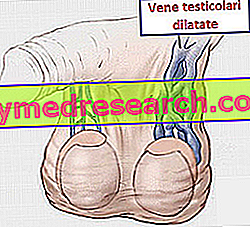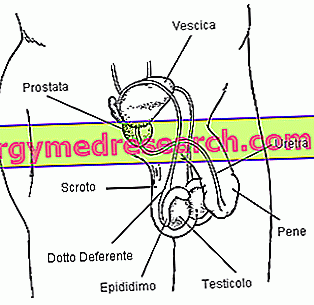Generality
A varicocele is a pathological alteration of the testicular veins, which have the function of draining the blood from the testicles. This alteration consists substantially in a dilation of the veins, which often causes a swelling at the affected testicle .

Figure: depiction of a varicocele in the left testicle. From the site: dilipraja.com
The precise causes that lead to venous dilation are still unclear.
Usually, the swollen testicle is the only manifestation of an ongoing varicocele; however, in some cases, symptoms such as discomfort or, even worse, pain may be added to the swelling. Furthermore, more severe varicoceles can lead to testicular atrophy and infertility.
For a definitive diagnosis, in many cases, only objective examination is sufficient.
Most varicoceles do not need any specific care; the use of surgery, in fact, occurs only in rare cases, for example in the presence of pain and / or testicular atrophy.
Short reference to the male genital system
The male genital apparatus is composed mainly of the following parts:
- Testicles or didymas . They are the male gonads, that is the main reproductive organs of the male. Contained in the scrotum (or scrotal sac), they are two in number and have the task of producing millions of spermatozoa, or male reproductive cells; they also produce male sex hormones (testosterone), fundamental in the development of primary and secondary sexual characteristics and in the control of the genital apparatus.
- Seminal vesicles and prostate . There are two seminal vesicles and they produce a viscous liquid similar to seminal fluid. The prostate, on the other hand, is the gland that produces and emits the real seminal fluid, an essential fluid to nourish the spermatozoa and form, together with the latter, the sperm.

- Urethra . It is a small channel that runs all over the penis, through which urine and seminal fluid (or sperm, if in the seminal fluid there are also spermatozoa) are expelled. The release of seminal fluid is called ejaculation. To check that urine and seminal fluid do not mix together, there is a sort of muscular valve.
- Penis . It is the male reproductive organ and the last part of the urinary tract. Thanks to its particular anatomical structure, it allows the passage of spermatozoa from man to woman.
What is varicocele?
A varicocele is a pathological dilation of the testicular (or spermatic) veins, which run along the spermatic cord and which have the task of draining the blood from the testicles.
The onset of a varicocele is one of the possible causes of a swollen testicle .
What is the spermatic cord?
The spermatic cord is a sort of peduncle or cord (in fact it is also known as a spermatic cord ), of soft consistency, with a diameter of about one centimeter and an average length of 14 centimeters.
Extended from the posterior side of the testicle to the abdominal orifice of the inguinal canal, the spermatic cord travels - proceeding from below - the scrotum and the inguinal canal.
The spermatic cord provides support to various structures; in fact, along its course reside:
- Blood vessels, such as the testicular artery, external spermatic artery, testicular veins and lymphatic vessels.
- Nerves
- The vas deferens
- The vaginal ligament
- Other
VARICOCELE AND VARICOSE VEINS
Varicocele and varicose veins are two morbid conditions with different points in common (from the possible causes to the associated symptoms).

From the site patient.co.uk
According to the WHO (World Health Organization), varicose veins (or varices ) are abnormal and saccular dilatations of the venous vessels. The most affected anatomical sites are the lower limbs.
Epidemiology
Many men suffer from varicocele; according to recent estimates, in fact, one man is every 7.
The subjects most affected are individuals aged between 15 and 25 years.
A varicocele can develop on both spermatic funiculars; however, it is much more frequent in the left testicular veins (about half of the cases), since, at the scrotal level, they make a more tortuous and favoring a varicocele path.
Right and simultaneous varicocele on both funiculars are very rare and rare, respectively.
Causes
The precise causes that induce the excessive dilation of the testicular veins are currently still unclear.
In this regard, the experts formulated two equally possible theories:
- According to a thesis, the problem would be due to a malfunction of the valve system on the inner wall of the veins. Under normal conditions, this valve system forces blood to travel in one direction, which is towards the heart; in the case of varicocele, their malfunctioning would allow the blood to turn back, modifying the anatomy of the venous vessels in which it stagnates.
- According to the other thesis, the problem would be the direct consequence of a blockage in the blood stream, located at the level of the abdominal venous vessels located after the testicular veins.
This block would prevent the blood from flowing out from the spermatic venous vessels, which, as a result, accumulate blood and dilate.
IDIOPATHIC VARICOCELE AND SECONDARY VARICOCELE
According to the experts, the malfunctioning of the venous valves (first thesis) would be the cause of the so-called idiopathic varicocele . Idiopathic varicocele is typical of adolescents and young adults.
The term idiopathic, which in the medical field is associated with pathologies that arise without identifiable causes, refers to the fact that the reason for which the malfunctioning of the venous valves is still unknown.
Idiopathic varicocele is usually a minor disorder.

Figure: first theory related to the possible causes of varicocele.
In healthy venous vessels (above), the valves prevent the blood from turning back. In the venous vessels in which the valve system is defective (below), on the other hand, the valves allow the blood to turn back and thus cause expansion.
From the site: patient.co.uk
On the contrary, according to experts, the blockage downstream of the testicular veins (second thesis) would be at the origin of the so-called secondary varicocele . In medicine, a pathology is called secondary when it arises due to a problem in other sites of the body (for example, secondary pulmonary hypertension that arises due to a thoracic tumor that pushes on the pulmonary arteries).
In many secondary varicoceles, it is suspected that the problem responsible for blocking the blood flow is the presence of a pelvic or abdominal tumor (for example a renal carcinoma ); tumor that compresses the venous vessels within which the blood coming from the testicular veins should flow.
Secondary varicoceles are typical of people over 40 years old.
NB: these definitions consider the two theories concerning the possible causes of varicocele to be true.
RISK FACTORS
Currently, there is still little clarity about risk factors. Some studies have shown that high stature would be a favoring characteristic; however, since not all very tall people suffer from varicocele, such research deserves further investigation and confirmation.
Symptoms and Complications
To learn more: Varicocele symptoms
Very often, the dilation of the spermatic veins manifests itself only with a testicular swelling ; in fact, most varicoceles are asymptomatic, that is, they do not cause obvious symptoms (or further signs).
The rare cases of symptomatic varicocele are characterized by a sense of discomfort and sometimes real pain at the swollen testicle .
In particular, the pain:
- Intensity increases when the patient has been standing for a long time during the day or has been engaged in strenuous physical activity.
- Increase in the evening.
- It decreases in intensity when the patient lies down on his stomach.
WHEN TO REFER TO THE DOCTOR?
In the presence of abnormal pain and swelling of the scrotum or of a difference in size between the two testicles, it is advisable to contact your doctor immediately, for a deeper understanding of the situation.
As already mentioned, varicocele is often asymptomatic and does not represent a serious disorder. However, its presence accompanied by the aforementioned disorders deserves a thorough medical evaluation. A neglect, in fact, could result, in an advanced phase of the illness, in one or more complications.
COMPLICATIONS
The most serious varicoceles can involve the following complications:
- Testicular atrophy . In medicine, the term atrophy refers to a reduction in the mass of a tissue or organ, caused by the decrease in cell volume (ie the cells that make up the affected tissue or organ).
Testicular atrophy, therefore, is a reduction in the size of one or both testicles .
In the case of varicocele, the affected testicle is obviously the one affected by the problem of testicular venous vessels.
The precise triggering causes are unclear. According to the most accredited theory, to provoke testicular atrophy would be the stagnation of venous blood at scrotal level; in this blood, in fact, there are toxins and waste products taken from the freshly sprayed tissues, which, stopping for a long time in the scrotum, would cause more or less serious damage to the testicle and a reduction in its volume.
Moreover, again due to the stagnation of venous blood, arterial blood circulation is hindered and insufficient to keep all testicular cells alive with varicocele.
- Male infertility . Like atrophy, male infertility would also appear to be due to the stagnation of blood in the testicular veins. According to experts, in fact, this would cause an abnormal increase in temperature around the testicles; temperature increase which, in the long run, jeopardizes sperm formation and sperm movement capacities.
Although it is a possible complication, male varicocele infertility is a very rare possibility.
Continue: Varicocele - Diagnosis and Treatment »




